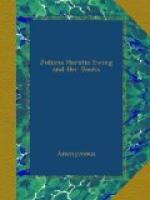To the volume of Aunt Judy’s Magazine for 1872 she gave her first “soldier” story, “The Peace Egg,” and in this she began to sing those praises of military life and courtesies which she afterwards more fully showed forth in “Jackanapes,” “The Story of a Short Life,” and the opening chapters of “Six to Sixteen.” The chief incident of the story, however, consisted in the Captain’s children unconsciously bringing peace and goodwill into the family by performing the old Christmas play or Mystery of “The Peace Egg.” This play we had been accustomed to see acted in Yorkshire, and to act ourselves when we were young. I recollect how proud we were on one occasion, when our disguises were so complete, that a neighbouring farmer’s wife, at whose door we went to act, drove us as ignominiously away, as the House-keeper did the children in the story. “Darkie,” who “slipped in last like a black shadow,” and “Pax,” who jumped on to Mamma’s lap, “where, sitting facing the company, he opened his black mouth and yawned, with ludicrous inappropriateness,” are life-like portraits of two favourite dogs.
The tale was a very popular one, and many children wrote to ask where they could buy copies of the Play in order to act it themselves. These inquiries led Julie to compile a fresh arrangement of it, for she knew that in its original form it was rather too roughly worded to be fit for nursery use; so in Aunt Judy’s Magazine (January 1884) she published an adaptation of “The Peace Egg, a Christmas Mumming Play,” together with some interesting information about the various versions of it which exist in different parts of England.
She contributed “Six to Sixteen” as a serial to the Magazine in 1872, and it was illustrated by Mrs. Allingham. When it was published as a book, the dedication to Miss Eleanor Lloyd told that many of the theories on the up-bringing of girls, which the story contained, were the result of the somewhat desultory, if intellectual, home education which we had received from our Mother. This education Miss Lloyd had, to a great extent, shared during the happy visits she paid us; when she entered into our interests with the zest of a sister, and in more than one point outstripped us in following the pursuits for which Mother gave us a taste. Julie never really either went to school or had a governess, though for a brief period she was under the kind care of some ladies at Brighton, but they were relations, and she went to them more for the benefit of sea breezes than lessons. She certainly chiefly educated herself by the “thorough” way in which she pursued the various tastes she had inherited, and into which she was guided by our Mother. Then she never thought she had learned enough, but throughout her whole life was constantly improving and adding to her knowledge. She owed to Mother’s teaching the first principles of drawing, and I have often seen her refer for rules on perspective to “My Childhood in Art,"[20] a story in which these rules were fully laid down; but Mother had no eye for colour, and not much for figure drawing. Her own best works were etchings on copper of trees and landscapes, whereas Julie’s artistic talent lay more in colours and human forms. The only real lessons in sketching she ever had were a few from Mr. Paul Naftel, years after she was married.




